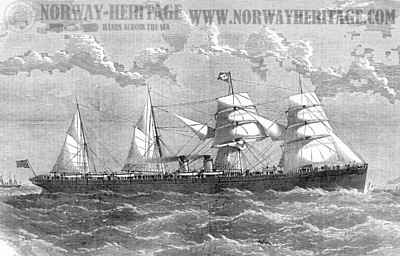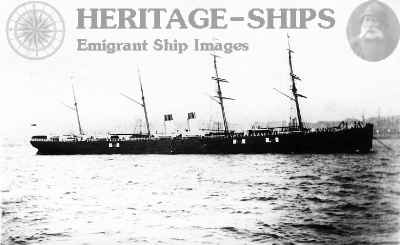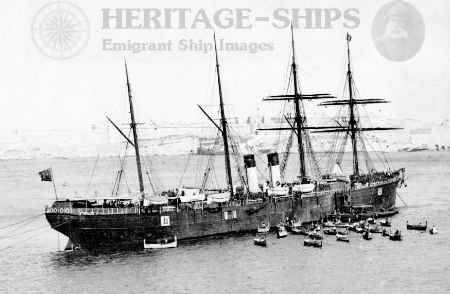
Picture of the S/S Egypt with
sails from an old engraving printed in The Illustrated London News, 1871
Support Norway Heritage: Purchase a copy

Photo of the S/S Egypt, National Line steamship
Support Norway Heritage: Purchase a copy
From the Illustrated London News, Nov. 18 1871:
THE STEAM-SHIP EGYPT.
The National Steam-Ship Company has added to its fleet of steamers, for the Liverpool and New York line, one called the Egypt, which is, we believe, except the Great Eastern, the largest steamship afloat. The Egypt is 450 ft. 6 in. in length, 44 ft. in breadth of beam, and 36 ft. in depth of hold ; and her gross measurement of burden is 5150 tons. She is fitted with engines constructed on the
compound principle, working up to 3000-horse power, and supplied with steam by six double boilers, arranged in two sets of three each, carrying a pressure of 75lb. to the square inch. The saloon is furnished with berths for 120 first-class passengers, and there is accommodation for 1410 in the
steerage. Nothing that can tend to the convenience and comfort of both classes of passengers has been neglected on board this vessel. She is, unlike some of the other ocean-going steamers, both a summer and winter ship, and has been built for speed combined with safety and great carrying capacity. She is a complete four-decker, with a spar-deck flush fore and aft - the only obstructions, and they are very slight, being the cabin entrances and skylights. This and the deck below are strongly plated with steel and planked with pine. The two lower decks are plated with iron amidships, where the general strain of the machinery is felt, and are also decked over in the same manner as the upper decks. The saloons, state-rooms, and officers' rooms are warmed by steam-pipes, which are far less dangerous than the heat generated by stoves, especially when a vessel is pitching in a heavy seaway. The ship has five steam-winches and a steam capstan and windlass of Napier's patent. The steam-winches supersede a vast amount of manual labour; they work the pumps, hoist the sails, and discharge and load the cargo. The Egypt, as shown in our Illustration, has four masts - the foremast, mainmast, mizzen, and jigger; and she can "let out" as much canvas as any vessel afloat; but bending canvas will hardly be necessary when she can forge ahead at the rate of about thirteen knots an hour by steam alone. All the lower masts are of iron, whilst the lower yards and lower topsail-yards (adopting the American principle of double topsail and yards) are made of steel, which secures lightness combined with strength. The vessel has steering apparatus both amidships and aft, and the "rudder work" is thus made doubly secure. The Egypt started from Liverpool, on her first voyage to New York, yesterday week, with 480 passengers and 3000 tons of cargo. She is commanded by Captain Frederic Grogan. The National Company's fleet consists of the Denmark, Virginia, Erin, Helvetia, Canada, France, The Queen, England, Italy, Holland, Spain, and Egypt. The Holland, which has been removed from the New York trade for a time, has just completed one of the fastest passages ever made between Liverpool and Calcutta by the Suez Canal, having made the run in thirty-three days, including two days occupied in passing through the canal.

The steamer Egypt at Malta, March 1881 conveying the 75th and 96th Regiments from Portsmouth
Support Norway Heritage: Purchase a copy